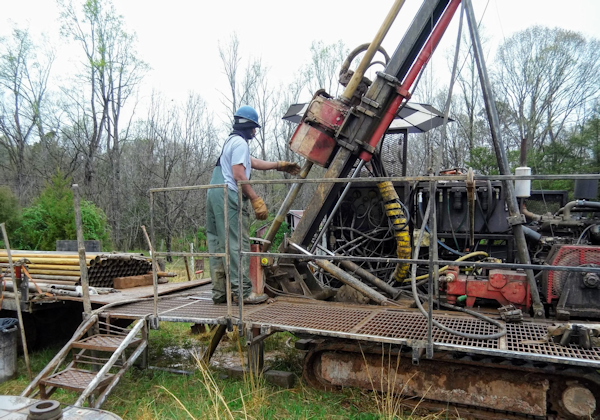SEJournal Online is the digital news magazine of the Society of Environmental Journalists. Learn more about SEJournal Online, including submission, subscription and advertising information.
 |
| A contractor for Piedmont Lithium operates a drill rig as the company tests for lithium deposits in Gaston County, North Carolina, in 2019. Photo: David Boraks/WFAE. |
Feature: Is EV-Driven Demand for Lithium on Collision Course With Environment Concerns?
By David Boraks
In the fight against climate change, putting more electric vehicles on roads is a critical strategy. And at least for now, that means more cars powered by lithium-ion batteries. Demand for lithium is already skyrocketing and the question is: Where will it come from?
The International Energy Agency estimates the world will need 40 times more lithium by 2040 to help meet the goals of the Paris Climate Agreement. There are concerns we won't have enough. To satisfy that demand, we'll need to open new mines or revive old ones.
Environmental journalists interested in examining where, when and how that happens will find plenty of reporting opportunities.
Follow the money
The Biden administration and Congress, through the Inflation Reduction Act, have made it a priority to develop a domestic supply chain for lithium and other "strategic minerals." Most of the world's lithium supply is processed in China. So the law includes billions of dollars in tax credits to subsidize mines and processing facilities in the United States, and to make EVs more affordable — but only if they meet standards for U.S.-produced materials.
Money is already flowing to companies
to open or expand processing in
North Carolina and Tennessee.
Money is already flowing to companies to open or expand processing in North Carolina and Tennessee.
This U.S. Geological Survey lithium deposits database can help you pinpoint potential sites in your local area. And permit applications running thousands of pages give you access to a wealth of details about proposed mines.
American lithium mining revival
One type of story to look for is how federal funds are being spent in the United States to support all these new mines and processing facilities.
 |
| Mines in Gaston County, North Carolina, once supplied most of the world's lithium from deposits in a mile-wide north-south band known as the Carolina Tin-Spodumene Belt. Image: Piedmont Lithium. |
Another equally compelling story is the climate versus environment conflict that comes with lithium mining — a story I've been following here in North Carolina.
We don't develop mines the way we used to in the United States. Tougher regulations and organized opposition mean you can't just bring in the heavy equipment and start digging.
The United States currently has only one active lithium mine, at Silver Peak, Nevada, operated by Albemarle Corp. of Charlotte, N.C.
Here, lithium is extracted by evaporating underground salt water in a process called lithium brine recovery. The U.S. Energy Information Administration says this mining technique could provide a reliable domestic supply of lithium.
Albemarle wants to double the mine's output. But for now, it's a small fraction of the lithium that the company produces. Most comes from mines in Chile and Australia.
To bring more lithium production back to the United States, Albemarle and other companies are proposing new mines wherever lithium deposits are found. The most promising sites are in North Carolina and the Southwest, including Nevada, California and Utah.
Mines in Gaston County, North Carolina, west of Charlotte, once supplied most of the world's lithium. Lithium deposits run through the county in a mile-wide north-south band, known as the Carolina Tin-Spodumene Belt (see map).
Spodumene is a mineral that contains lithium. It's extracted as rock from open pits hundreds of feet deep. These mines operated for decades in the 20th century, until cheaper sources were found in South America and Australia.
Albemarle owns one of those old lithium mines, off Interstate 85 in Kings Mountain, North Carolina. It operated from the 1940s to the 1980s, when the company shifted production to overseas sources.
That open pit mine is now a lake, surrounded by a hiking trail. But with the price of lithium rising with demand, Albemarle says it makes sense to reopen it. The company has made its pitch to neighbors in large and small public meetings and through a website touting its benefits.
Willing sellers vs. worried opponents
Meanwhile, about a dozen miles north, a startup company called Piedmont Lithium wants to construct a mine and processing operation in a rural area that's now mostly residential properties and farm fields. Piedmont wants to dig four open pit mines averaging 500 feet deep and construct a lithium processing plant nearby.
 |
| A roadside sign near Piedmont Lithium's proposed mine site in Gaston County, North Carolina. Photo: David Boraks/WFAE. |
"There is very little production of lithium raw materials, or any battery raw materials, in the U.S. The potential's there, but it'll take time to bring it online," Piedmont Lithium CEO Keith Phillips told me when I spoke to him about the proposal last fall for NPR.
Some residents in the area have willingly sold their land to Piedmont, in some cases for millions of dollars.
But the mine also faces significant opposition from both neighbors and local officials. They worry about the loss of their way of life, environmental damage and threats to streams flowing through the area.
The company still needs a state mining permit, but has yet to give state mining officials plans for treating wastewater from the site.
And even if Piedmont gets the permit, it will still need county zoning approval.
County Commission Chair Chad Brown told me last fall: "With the information I have right now, I probably would not call for a vote on this. I would have to have tons of more information just for the environmental side, [including] air quality, water quality, different things like that."
The company acknowledges that approvals have come more slowly than expected. "Our plan, our hope, is that we'll be in production in Carolina in 2026, and will be fully permitted and approved and funded sometime in 2024," Phillips said.
Big plans for the West
Fights against mines aren't limited to North Carolina.
Another project facing organized opposition is a massive mine planned by Lithium America for Nevada's Thacker Pass. The company recently won a round in court when a federal judge declined to halt the project.
But as Inside Climate News has reported, tribes, ranchers, residents and activists are worried that the need for lithium isn’t worth the proposed mine's negative effects.
‘We’re here because our allegiance is
to the land. It’s not to cars. It’s not to [a]
high-energy, modern lifestyle. It’s to this place.’
— Anti-mine activist Max Wilbert
"We want people to understand that ‘clean energy’ is not clean," anti-mine activist Max Wilbert told Inside Climate News. "We’re here because our allegiance is to the land. It’s not to cars. It’s not to [a] high-energy, modern lifestyle. It’s to this place.”
Similar sentiments have prompted members of the Quechan Tribe, like Preston J. Arrow-weed, to speak out against proposed lithium mining near California’s Salton Sea.
Even word of exploration for lithium brings out opponents. That's what happened in Utah when residents learned that an Australian company wanted to look for lithium at the site of former oil and gas wells near the city of Moab.
Supporters cite political imperatives
But for every opponent, there's a local official, EV supporter or federal politician ready to make the argument for mining.
When Piedmont Lithium dedicated its new headquarters in Belmont, North Carolina, last summer, Sen. Thom Tillis argued that the United States needs its own sources of lithium and lithium processing facilities to counter China.
"The Chinese have a stated strategy of being the world's economic and military superpower by 2050. And they don't intend to do that through a great war. They intend to do it by putting their tentacles around the globe, economically," Tillis said. "They intend to make sure that the Western world is dependent upon them for lithium, for tantalum, for rare earth minerals, so that they can literally beat us by never firing a shot."
Tillis said he supports Piedmont's plans, but in a nod to opponents he added: As long as it's done in an environmentally responsible way.
And speaking of the environment: As you're reporting, one last question to ask is what happens to the mine once it's tapped out?
Decades ago, mining companies didn't have to figure that out ahead of time — if at all. Now, reclamation plans are required. Those can yield stories about how much money companies are setting aside and whether those plans are realistic.
David Boraks is a veteran journalist and member of the Society of Environmental Journalists who covers climate change for WFAE, the NPR affiliate in Charlotte, North Carolina. He also has covered housing and homelessness, energy and the environment, transportation, and business. His 2021 WFAE project "Asbestos Town," about the legacy of asbestos in a small North Carolina town, won Best Radio Documentary from the Society of Professional Journalists.
* From the weekly news magazine SEJournal Online, Vol. 8, No. 15. Content from each new issue of SEJournal Online is available to the public via the SEJournal Online main page. Subscribe to the e-newsletter here. And see past issues of the SEJournal archived here.













 Advertisement
Advertisement 



